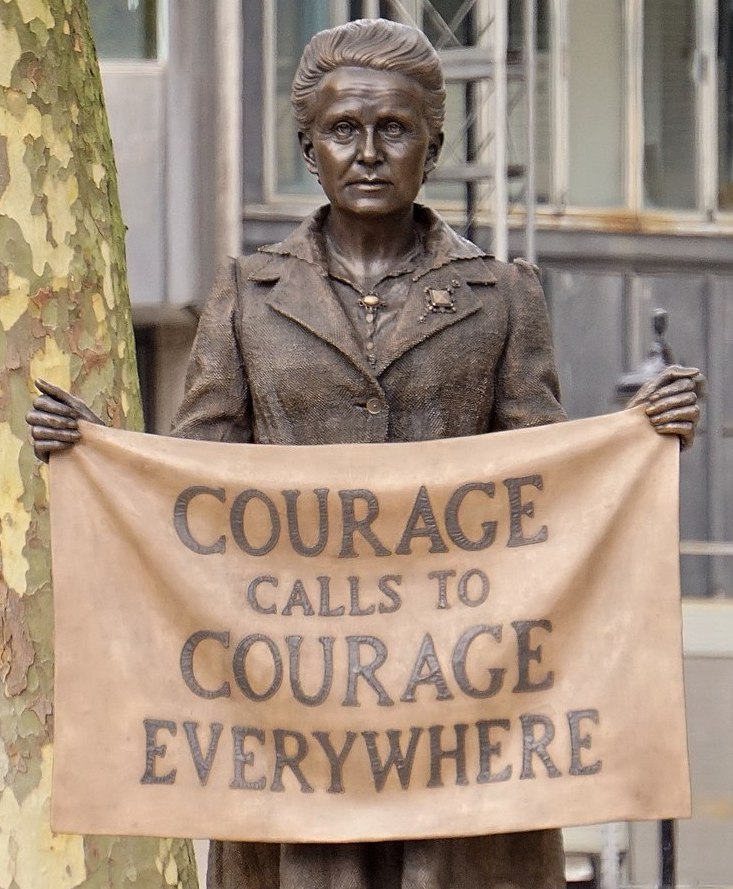The first woman commemorated with a statue in Parliament Square
The first woman to be commemorated with a statue in Parliament Square was the suffragist campaigner Dame Millicent Garrett Fawcett. The statue by Gillian Wearing, unveiled in Parliament Square in 2018, is pictured above.
Millicent campaigned for women’s suffrage through legal change and led Britain’s largest women’s rights association, the National Union of Women’s Suffrage Societies, from 1897 to 1919.
Her elder sister, Elizabeth Garrett Anderson, became Britain's first female doctor and was a significant influence on Millicent.
Then, in July 1865, aged 17, Millicent heard the philosopher and politician John Stuart Mill address an election meeting and commented, “This meeting kindled tenfold my enthusiasm for women’s suffrage”.
On 20 May 1867, Millicent sat in the Ladies’ Gallery of the House of Commons when John Stuart Mill tried to introduce his famous amendment to the 1867 Representation of the People Bill. As a Member of Parliament, Mill tried unsuccessfully to amend the Reform Bill and have the word ‘man’ substituted with ‘person’.

Dame Millicent Garrett Fawcett 1847 - 1929
In Death at Crookham Hall, I mention how suffragists targeted the Ladies’ Gallery. In the 1830s, the grilles had been designed to screen the ladies in the Gallery from the men below. MPs were not to be distracted by women watching them at work. The grilles restricted the view of the debating chamber and made the Ladies’ Gallery extremely hot. To suffragists, they became a symbol of repression.
In 1908, Helen Fox and Muriel Matters of the Women’s Freedom League chained and padlocked themselves to the grilles while Violet Tillard pushed a large banner through the latticework on the end of a rope into the debating chamber below.
Two months after her visit to the Ladies' Gallery, Millicent attended the first meeting of the National Society for Women’s Suffrage and joined its executive committee.
She once stated: "I cannot say I became a suffragist. I always was one, from the time I was old enough to think at all about the principles of Representative Government."
Millicent disapproved of the tactics employed by more militant organisations such as the Women's Social and Political Union (WSPU), whose motto was ‘Deeds not Words’. Millicent believed their actions would turn public (and parliament’s) opinion against them and damage the prospects of women gaining the right to vote.
In her book, What I Remember, Millicent said:
I could not support a revolutionary movement, especially as it was ruled autocratically, at first, by a small group of four persons, and latterly by one person only.... In 1908, this despotism decreed that the policy of suffering violence, but using none, was to be abandoned. After that, I had no doubt whatever that what was right for me and the NUWSS was to keep strictly to our principle of supporting our movement only by argument, based on common sense and experience and not by personal violence or lawbreaking of any kind.
During the First World War, the NUWSS turned their activities towards the war effort, supporting hospital services in training camps and financing women's hospital units.
After the war, in 1919, the NUWSS renamed itself the National Union of Societies for Equal Citizenship and continued to campaign for equal rights.
In the 1925 New Year Honours, Millicent was appointed Dame Grand Cross of the Order of the British Empire (GBE).
Dame Millicent Garrett Fawcett died in 1929 at the age of 82. In 1932, a memorial to Fawcett was unveiled in Westminster Abbey with the inscription: "A wise constant and courageous Englishwoman. She won citizenship for women.”
In 2018, to commemorate the centenary of the Representation of the People Act, which had granted limited franchise, Millicent became the first woman commemorated with a statue in Parliament Square.
The Iris Woodmore Mysteries are available in hardback, paperback, ebook and audiobook from Amazon and bookstores.

